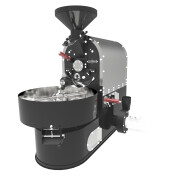
How is Coffee Grown: A Journey from Seed to Cup
Coffee is one of the most beloved beverages worldwide, and the journey of coffee—from seed to cup—is truly fascinating. For coffee roasters and enthusiasts alike, understanding how coffee is grown can deepen appreciation for the beans that end up in the roaster. Here, we’ll take a closer look at where coffee grows, how it’s cultivated, and the stages of coffee plant growth.
How Does Coffee Grow?
Coffee grows on evergreen shrubs or small trees primarily in tropical climates. Coffee plants thrive in rich, well-drained soil with plenty of rainfall and moderate temperatures. Most coffee grows between the Tropics of Cancer and Capricorn, where conditions allow for the development of high-quality beans. These shrubs produce cherries, the fruit that encases the coffee beans, in climates with ample sunlight and moderate shade.
The process of cultivating coffee begins with planting seeds, typically in shaded nurseries. Once established, young coffee plants are transplanted to plantations, where they’ll be carefully maintained over several years before producing their first harvest.
Where Does Coffee Grow?
Coffee is primarily grown in countries along the "Coffee Belt," which spans parts of Central and South America, Africa, Asia, and the Caribbean. Top coffee-growing countries include Brazil, Colombia, Ethiopia, Vietnam, and Costa Rica, each with unique flavors due to the local climate, altitude, and soil. For roasters, each origin brings distinct characteristics to the final cup, making sourcing and roasting an art and a science.
Coffee Plant Growth Stages
The growth of a coffee plant occurs in several key stages:
-
Germination and Seedling Stage: Coffee seeds are planted in shaded nurseries, where they germinate and develop into young plants.
-
Young Plant Development: At around six months, these seedlings are transferred to the main plantation, where they receive constant care, including weeding, fertilizing, and pest control.
-
Flowering: After two to four years, coffee plants start flowering, producing small, fragrant white flowers. Flowering depends on the rainy season and signals that cherries will soon begin to develop.
-
Cherry Development and Ripening: The cherries start green, gradually turning red or yellow when ripe, which typically takes 7-9 months depending on the variety and climate.
-
Harvesting: When the cherries are fully ripened, they’re harvested by hand or machine, marking the end of their growth journey and the beginning of their transformation into coffee beans.
How Long Does It Take to Grow Coffee Beans?
Growing coffee requires patience. Coffee plants generally take three to four years to begin producing their first crop, with cherries ripening roughly 7-9 months after flowering. The slow development of coffee cherries is crucial for quality, as it allows flavors to mature, leading to beans rich in complexity and depth. This timeline can vary based on altitude, temperature, and the specific coffee variety.
How Many Pounds of Coffee per Tree?
The yield of coffee beans per tree depends on factors such as variety, climate, and cultivation practices. On average, a single coffee tree produces about 1-1.5 pounds of roasted coffee annually. This means coffee farmers must maintain large numbers of trees to meet production needs, making coffee farming a labor-intensive process. For roasters, each pound of coffee represents the dedication and hard work of countless coffee farmers.
Growing coffee is a meticulous and time-intensive process, with every stage affecting the final flavor of the coffee beans. For coffee roasters looking to deliver exceptional coffee, understanding the growth journey of coffee plants is essential. Visit Coffedroasters.com to learn more about our state-of-the-art coffee roasting machines. We specialize in designing and manufacturing roasters that honor the journey of each coffee bean, ensuring that every roast captures the unique flavors developed during the growth process.






